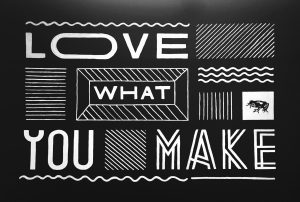
add some words
[OLD FALL 2017] 15-104 • Introduction to Computing for Creative Practice
Professor Roger B. Dannenberg • Fall 2017 • Introduction to Computing for Creative Practice

add some words
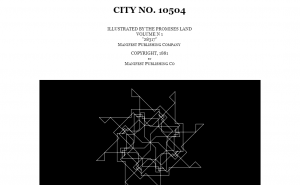
Loren Schmidt and Katie Rose Pipkin’s inflorescence.city (volume 1) is an example of generative art I find particularly intriguing. inflorescence.city is a procedurally generated series of texts, visualizations, and small interactive pieces that form an imaginary publication from an imaginary city. Each section of the publication is created by a different set of algorithms drawing from different source material. To make the project, which began as part of “National Novel Generation Month” but ended up extending beyond that, Schmidt and Rose used a combination of their own code and algorithms created by others, working in JavaScript, HTML5 canvas, and some Ruby.
I was drawn to the project partly because of its combination of both generated text and generated art, as well as its feel—even though the text is sometimes incoherent, the many different topics and sections make it seem more personal than a single piece of generated text. It’s interesting to think about where either of those particular aspects could go in future projects, whether they might lead to completely generated books (with text/ image combinations) or explorations of how something might feel more “human-made” than “computer-generated.”
inflorescence.city vol. 1 by Katie Rose Pipkin and Loren Schmidt (http://inflorescence.city)
Additional information about the work: an interview with Pipkin and Schmidt & a description from the Electronic Literature Knowledge Base.
Creator: John Karborn
Title of Work: Evidence of Time Travel
Year of Creation: 2012 – 2014
Link to Project Work: http://www.evidenceoftimetravel.com/
Link to Artist Bio: http://www.karborn.com/
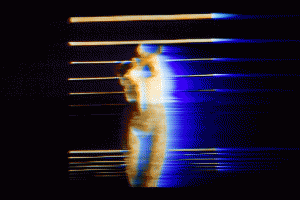
Because of the nature of my work (performance, video, sound), the work of John Karborn — specifically his Evidence of Time Travel series done in collaboration with musicians John Foxx and Steve D’Agostino — has contributed directly to my working methods. Karborn’s series was created by feeding still and moving images into modification hardware such as wobbulators and analogue video machines which he documents via DSLR captures off the output screen. Doing this to multiple images and videos coherently to produce a full series of 9 works (i.e. the AV, performance-based project Evidence of Time Travel) while collaborating indirectly with the sounds and audio created by musicians took Karborn roughly two years. Custom hardware is often created to produce desired modifications which he then further modifies by disrupting the image code in software such as Audacity.
In the realm of new media art, Karborn’s Evidence of Time Travel series points towards the direction of utilizing audio to tamper, modify, and fragment the data of visual messages. Although code is not his primary modifier, Karborn has contributed to explorations in the production of graphic images whose data has been intentionally corrupted and/or disrupted.
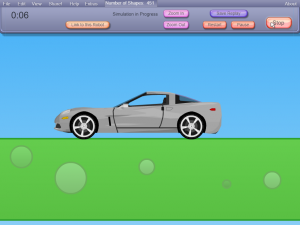 What you’re seeing now is a Corvette LT3 made by someone on an online flash physics game called Incredibots. In this game, it offers you various types of geometric shapes and allows you to edit these shapes and put them together using parts called “joints”. With various types of joints, you can allow your creation to rotate, expand and contract, bounce, and even fly. When you are finished, you can put your creation into a “simulation” and see it function and interact with the environment and/or other creations you made. The best part of the game was that you can (not anymore) share your creation to an online community; allowing other creators to see what you made and share/respond to it similarly to YouTube. The game was first developed in 2008 by a team of 4-5 developers: two people as the original developers, one person that did the art, one person that develops the game now, and one person that did the technical writing. The game ran on an already existing engine called “Box2D”, a physics engine that powered most physics games of the late 2000s (most popularly Angry Birds).
What you’re seeing now is a Corvette LT3 made by someone on an online flash physics game called Incredibots. In this game, it offers you various types of geometric shapes and allows you to edit these shapes and put them together using parts called “joints”. With various types of joints, you can allow your creation to rotate, expand and contract, bounce, and even fly. When you are finished, you can put your creation into a “simulation” and see it function and interact with the environment and/or other creations you made. The best part of the game was that you can (not anymore) share your creation to an online community; allowing other creators to see what you made and share/respond to it similarly to YouTube. The game was first developed in 2008 by a team of 4-5 developers: two people as the original developers, one person that did the art, one person that develops the game now, and one person that did the technical writing. The game ran on an already existing engine called “Box2D”, a physics engine that powered most physics games of the late 2000s (most popularly Angry Birds).
This game inspires me because it allows you to make your creations, that only existed in your head, become a reality. The best part to me was that you could share what you made to the world and allow the audience to interact with it. This game has played a large role in my childhood and inspired me to learn programming and computer game making in the first place. I always loved it when people play a game or creation I made and either leave a comment, share it, or make a video on it.
What makes this game awesome is the idea that inspired me in the past to do what I love to do now. It allows players to finally build their crazy or innovative ideas and make them come to life in such a fun way. The online community it once had would have also allowed these players to become inspired and work harder to come up with much more innovative and more functional creations to impress not only themselves, but also the community. Soon these players might grow and move on to make better and cooler things. This game is great for children who are limited to only pen and paper and want to make something even more amazing and visually animated with their ideas. They can also share what they made to a much broader audience rather than only their parents. Incredibots, in my opinion, is a game all children should play at least once. It’s a game that doesn’t mindlessly teach children simple ABC’s and 123’s like many child teaching games out there on the app store. This is a game that allows children to not only be creative, but also explore and make their own solutions for problems and to think of ways for their creations to look and function the way they want it to. This is a game that encourages players to think artistically and technically.
Ever since AR(Augmented reality) was introduced, I was always fascinated with the idea of looking through different lens for amazing experience. I find all the AR art works to be very inspiring and useful. I have seen lots of videos on artists using AR as tool to bring still image come to life or even sculpture. Particular thing I find on usage of AR is that it can be cooperated easily with anyone with smartphones and Holo lens in future. It has such a potential to be used for everyday life and bring indirect experience to be more closer to each individuals.
I have tried to use the free AR kit which was ARToolkit to create my own AR, but process was rather complicated and had steep learning curve. I am sure that artists who have used the similar program has gone through many hours of figuring how to make camera recognize image and engage the viewer to it.
Here are some videos on example of AR.
This is museum in Japan, Nagoya. They have used the AR through out the whole museum to bring still images to life.
link: https://www.youtube.com/watch?v=crScMhWjHJE
Artist is unclear from the video, but we can see that arts become more engaging to the audience.
link: https://www.youtube.com/watch?v=lq8lwGnbKIc
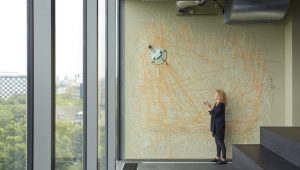
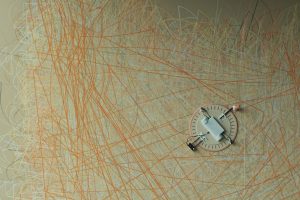
Sensing Colorspace, Michael Sebastian Haas, Berlin, 2014, waterbased acrylic paint & protoc ol, custom mechatronic system & custom software, 4,5x 3,8 meters
http://sonicedevelopment.com/sensing-colorspace/
There is an artwork “Sensing Colorspace” that I saw on a website before. It is installed at the 10th floor bar of the 25hours Hotel Bikini Berlin. I was attracted by this artwork at the first glance because the sense of chaos amazed me at first. I wasn’t sure why this was art and did not know the meaning of it. After reading the description, I start to love this piece of art. This drawing is created by a robot, Vertwalker, that was made by artist Michael Sebastian Haas. It records the noise in the surrounding and reflects it through drawing lines. The idea of bringing daily life, like the noise of the coffee machine, the dishwasher, people’s chatting, and the glass cup, into artwork already makes this work attractive. The use of technology – a self-developed robot makes this work even more valuable. Vertwalker is able to work for several hours until it needs to charge, which makes it able to work continuously to record the noise. This is very inspirational for me because I have never thought of letting a robot to make art, nor did I think that the production of a robot is art. However, the meaning behind this work that “records the interaction between visitors and the artwork and inscribes their presence to the wall”.
This is a test
The first time that I got to know TeamLab was an exhibition done by them in Singapore, the topic was the future city. I was amazed how new media can present concepts so lively, and engaging. when I saw people were attracted and actively participated in the exhibition by imagining and drawing out the future cities in their minds, I thought that was an exhibition should be like, an event that can not only build a connection between the artists and viewers, but also ignite discussions among them. In their exhibitions, they turn the audiences to participants. To me, this interaction is what the prime aim of art display and exhibition.
I found their recent project, “the way of birds” is presented in a more intriguing manner. Still using the new media and computational methods as main media, the image that they convey is strong and evocative. however, slightly, differently, they present this project in a way that both floors, ceilings are used besides walls, as presenting “screens”. Ths act breaks the boundary of horizon, and this undulating presentation creates an overwhelming feeling, that makes the viewers experience either drowning in deep, or being surrounded and embraced by the sky. As they proposed, the space is made for contemplation. This setting, and of course, with the help of computer generated imaging, fulfilled this goal by creating a space that seems to trace back to the very beginning of human life, the womb. without the new media tool, this experiential environment can never be achieved.
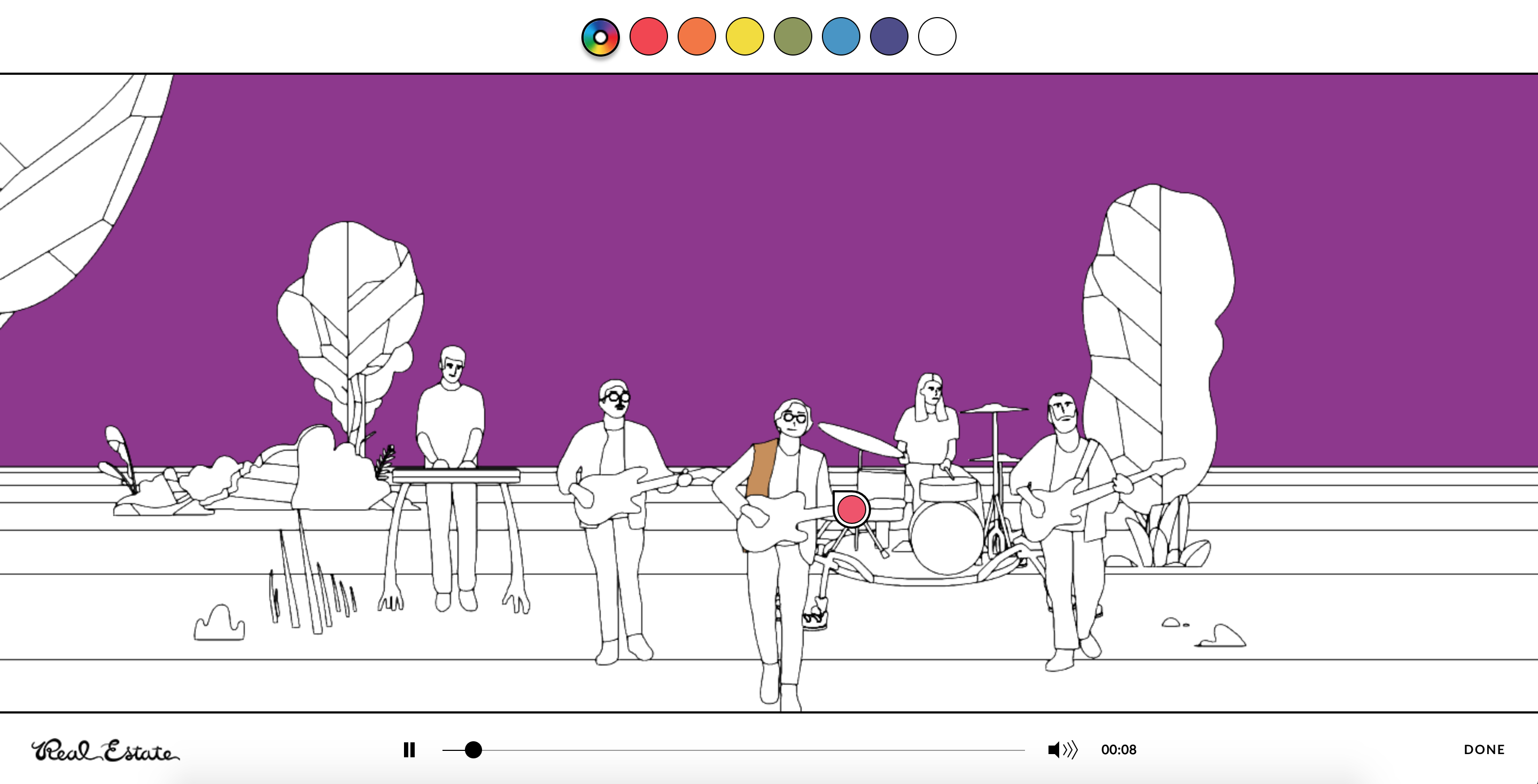
Screenshot of the website in midst of being colored
This is an interactive music video in which the video plays in black outlines and no color so that the watcher can select various colors and color the music video themselves. At the end, they can watch their own colored version of the music video and share with friends on social media. The song is called “Stained Glass” by the band Real Estate for the release of their new album “In Mind”. The video was created in collaboration with Wieden + Kennedy group creative director Craig Allen and the digital production company MediaMonks. It’s likely there was a team of 4-7 people that helped out, although I’m not as familiar with the advertising/branding industry, and there isn’t information on how long it took. Since it was with a large agency, it’s likely the band had access to industry-standard resources in creating it.
On a superficial level, this inspires me because it’s just so pretty and fun; it recalls childhood days of coloring in coloring books and pays homage to adult zentangle coloring books that help destress. I’m also baffled at the implementation— I literally haven’t the slightest idea at how they did it and I love that.
The strength of this piece lies in the conceptual reason of why this inspires me. The site allows music listeners to have a new way of interacting with an otherwise passively listened entertainment. The music industry struggles to compete with easier forms of entertainment/socializing such as eating out or netflix. The traditional model of planning months in advance, committing an entire evening or more to travel to a venue to watch something. I can see this microsite as a concept for web-based concerts: instead of simply watching a livestream, there could be elements such as color, and light that the audience can interact with (think Twitch plays rock concert). I believe audience participation is key to growing the entertainment industry. From a design/business perspective, too much of passive entertainment is already free (even active entertainment like video games are free). One could even make revisions to this piece for those who prefer passive entertainment by providing an option for people to work with existing versions that people have colored. On the other hand, from an artistic perspective, interactive art is valuable because it feels like the artist isn’t having a one-sided conversation with the audience; instead, the artist and the audience can generate an idea together.
Testing here.
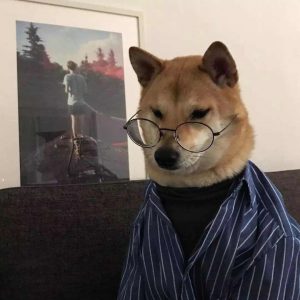
Smart puppers.